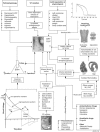High defibrillation threshold: the science, signs and solutions
- PMID: 20084193
- PMCID: PMC2803603
High defibrillation threshold: the science, signs and solutions
Abstract
Defibrillation threshold (DFT) testing has traditionally been an integral part of implantable cardioverter defibrillator (ICD) implantation. With the increasing number of patients receiving ICDs, physicians are encountering high DFT more often than before. Tackling the problem of high DFT, warrants an in-depth understanding of the science of defibrillation including the key electrophysiological concepts and the underlying molecular mechanisms. Numerous factors have been implicated in the causation of high DFT. Due consideration to the past medical history, pharmacotherapy, laboratory data and cardiac imaging, help in assessing the pre-procedural risk for occurrence of high DFT. Drugs, procedural changes, type and location of ICD lead system are some of the key players in predicting DFT during implantation. In the event of encountering an unacceptably high DFT, we recommend to follow a step-wise algorithm. Ruling out procedural complications like pneumothorax and tamponade is imperative before embarking on a search for potentially reversible clinical or metabolic derangements. Finally, if these attempts fail, the electrophysiologist must choose from a wide range of options for device adjustment and system modification. Although this review article is meant to be a treatise on the science, signs and solutions for high DFT, it is bound by limitations of space and scope of the article.
Keywords: DFT; Defibrillation threshold testing; implantable cardioverter defibrillator.
Figures

Similar articles
-
Implantable Cardioverter Defibrillator Implantation with or Without Defibrillation Testing.Card Electrophysiol Clin. 2018 Mar;10(1):119-125. doi: 10.1016/j.ccep.2017.11.012. Epub 2017 Dec 14. Card Electrophysiol Clin. 2018. PMID: 29428133
-
Defibrillation threshold testing: is it necessary during implantable cardioverter-defibrillator implantation?Med Hypotheses. 2009 Feb;72(2):147-9. doi: 10.1016/j.mehy.2008.09.032. Epub 2008 Nov 5. Med Hypotheses. 2009. PMID: 18980811
-
High defibrillation threshold with right-sided ICD implantation was resolved by a dual coil lead via persistent left superior vena cava.J Cardiol Cases. 2021 Nov 22;25(5):262-265. doi: 10.1016/j.jccase.2021.10.012. eCollection 2022 May. J Cardiol Cases. 2021. PMID: 35582083 Free PMC article.
-
Defibrillation threshold testing during implantable cardioverter defibrillator implantation: 5-year follow-up.J Interv Card Electrophysiol. 2021 Apr;60(3):485-491. doi: 10.1007/s10840-020-00733-x. Epub 2020 May 13. J Interv Card Electrophysiol. 2021. PMID: 32399866 Clinical Trial.
-
Defibrillation testing during implantation of the subcutaneous implantable cardioverter-defibrillator: a necessary standard or becoming redundant?Neth Heart J. 2020 Aug;28(Suppl 1):122-127. doi: 10.1007/s12471-020-01448-4. Neth Heart J. 2020. PMID: 32780342 Free PMC article. Review.
Cited by
-
Alterations in implantable cardioverter defibrillator lead parameters following left ventricular assist device implantation.JHLT Open. 2025 Jul 21;10:100350. doi: 10.1016/j.jhlto.2025.100350. eCollection 2025 Nov. JHLT Open. 2025. PMID: 40837543 Free PMC article.
-
Shock vector modulation via axillary vein coil in a right-sided implantable cardioverter-defibrillator.HeartRhythm Case Rep. 2023 Oct 9;9(12):935-938. doi: 10.1016/j.hrcr.2023.10.003. eCollection 2023 Dec. HeartRhythm Case Rep. 2023. PMID: 38204839 Free PMC article. No abstract available.
-
Traumatic Tension Pneumothorax as a Cause of ICD Failure: A Case Report and Review of the Literature.Case Rep Cardiol. 2014;2014:261705. doi: 10.1155/2014/261705. Epub 2014 Oct 7. Case Rep Cardiol. 2014. PMID: 25400953 Free PMC article.
-
Effect of substance abuse on defibrillation threshold in patients with implantable cardioverter-defibrillator.Pacing Clin Electrophysiol. 2011 Feb;34(2):193-9. doi: 10.1111/j.1540-8159.2010.02907.x. Epub 2010 Oct 14. Pacing Clin Electrophysiol. 2011. PMID: 20946279 Free PMC article.
-
A Novel Solution for the High Defibrillation Threshold in Patients with a DF-4 Lead: Adding a High Voltage Adaptor/Splitter.Indian Pacing Electrophysiol J. 2014 May 25;14(3):152-6. doi: 10.1016/s0972-6292(16)30756-2. eCollection 2014 May. Indian Pacing Electrophysiol J. 2014. PMID: 24920870 Free PMC article.
References
-
- A comparison of antiarrhythmic-drug therapy with implantable defibrillators in patients resuscitated from near-fatal ventricular arrhythmias. The Antiarrhythmics versus Implantable Defibrillators (AVID) Investigators. N Engl J Med. 1997;337:1576. - PubMed
-
- Klein H, et al. New primary prevention trials of sudden cardiac death in patients with left ventricular dysfunction: SCD-HEFT and MADIT-II. Am J Cardiol. 1999;83:91D. - PubMed
-
- Nanthakumar K, et al. Prophylactic implantable cardioverter-defibrillator therapy in patients with left ventricular systolic dysfunction: a pooled analysis of 10 primary prevention trials. J Am Coll Cardiol. 2004;44:2166. - PubMed
-
- Lee DS, et al. Effectiveness of implantable defibrillators for preventing arrhythmic events and death: a meta-analysis. J Am Coll Cardiol. 2003;41:1573. - PubMed
-
- Liu QM, et al. Defibrillation threshold testing: is it necessary during implantable cardioverter-defibrillator implantation? Med Hypotheses. 2009;72:147. - PubMed
LinkOut - more resources
Full Text Sources
Miscellaneous
